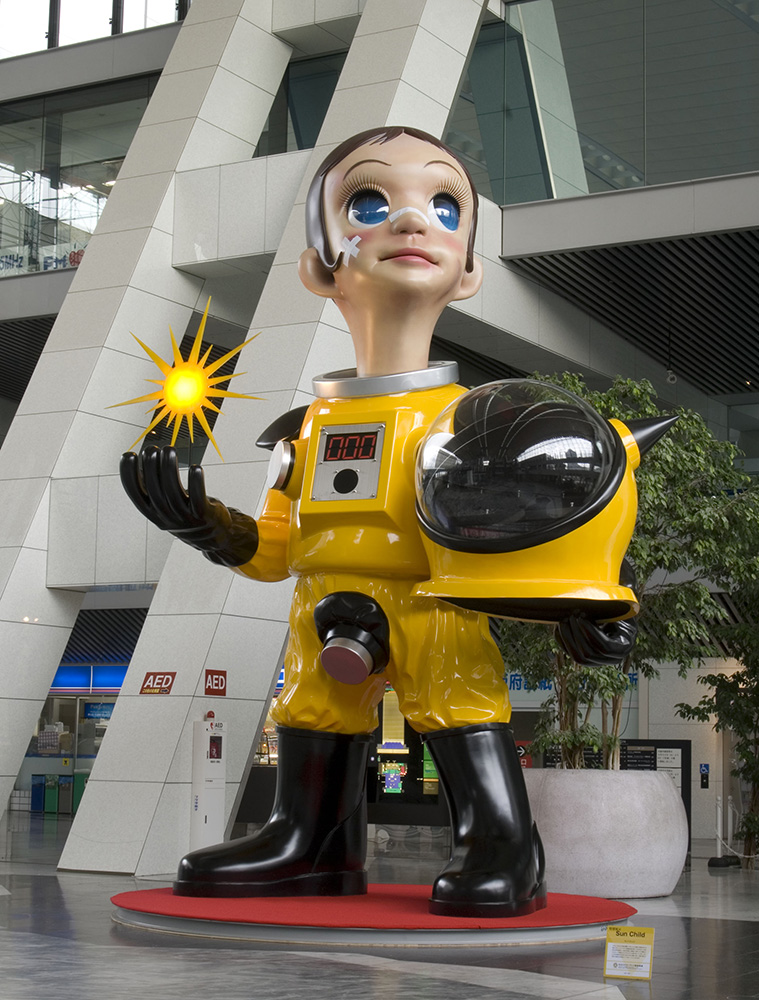Gigantic Sculptures to Change the World [2017]
One might be under the impression that Kenji Yanobe is an artist who has produced large-scale sculptures in recent years. However when his works are looked at carefully, his subjects and styles of works seem to change in response to the situations in society, and his creation has undergone many transitions before he began creating his current gigantic sculptures.
His debut work Tanking Machine (1990), where people could meditate inside a tank filled with a physiological salt solution, is a metaphoric return to a womb. This gave him the opportunity to look into himself and be filled with imagination, and so then he was “born” as the artist Kenji Yanobe. Later, he produced mechanical sculptures which people could wear or drive in order to “survive” the threatening end of the century. Following this period, he has attempted to transform reality into a story while expanding perception as well as body.
The Great Hanshin Earthquake and The Tokyo subway sarin attack, caused by his own generation influenced by subculture, gave him a huge shock. He then started the Atom Suit Project (1997–2003) in which he wore a protective Atom Suit and visited several places including Chernobyl. His homemade suit was able to detect radiation, and he had worn this in a bid to bridge the gap between the delusional world and reality. However, when he encountered Samosely (self-settling residents of the 30 kilometers exclusion zone of the Chernobyl Nuclear Power Plant) and saw their harsh reality before his eyes, he regretted deeply that he exploited their reality only for his artistic production and become guilt-ridden.
Subsequently, he began to raise the alarm over nuclear energy and atomic power in his works as a means of his atonement and revival. In the beginning of the 21st century, he changed his theme into “revival”, and started to be aware of the next generation, which coincided with the birth of his son. At the same time, he began the Torayan series in which he got the inspiration from a ventriloquist puppet that his father would perform with after his retirement, and assigned Torayan the role of a spokesperson and mediator on his own behalf.
In 2004-05, he stayed at the 21st Century Museum of Contemporary Art, Kanazawa for half a year to produce Giant Torayan, an aluminum sculpture with 7.2 meters in length, in cooperation with the project staff and local volunteers marking the opening of the museum. It was his first large-scale sculpture.
In 2008, he was assigned as the director of ULTRA FACTORY, a production studio at Kyoto University of the Arts and built up a collective production system of large-scale sculptures.
After the Great East Japan Earthquake and Tsunami and the Fukushima Daiichi nuclear disaster in 2011, what he had been concerned about becoming a reality actually did. He also had to be confronted with the fact that his warning did not have much effect. He altered the direction of his creation toward an optimist way in order to change reality for the better. He created Sun Child (2011-12) with the total height of 6.2 meters as a monument of hope, and one of the three bodies was permanently installed in Ibaraki City where Yanobe grew up.
This substantially became his first public art. After 2010, many art festivals started to be held in various places in Japan. Yanobe continued creating large-scale sculptures at ULTRA FACTORY, and his works were exhibited in many festivals. His sculptures are solid and durable even when they are made only for temporary occasions, and hence, the same work could be used in other exhibitions or some could be installed permanently, attracting public attention. Despite their hugeness, the sculptures’ sizes are within handmade-able scope. In away they are within the human scale–which is another reason for these works’ popularity.
Meanwhile, people’s understanding of Yanobe’s past works had ironically deepened after the natural disasters, the Nuclear Power Plant accident, and also due to the volatile society. His theme “survival” became a realistic and practical agenda. As Yanobe could foresee the future, he could entrusted himself with the responsibility of creating large-scale sculptures with the ability to widely disperse hope.
The sculptures produced under his story of hope resonate with people and local histories, generating various occurrences that sail back to the origin of art. For him, installing the gigantic sculptures in many places is an attempt to transform reality into the story of hope.
